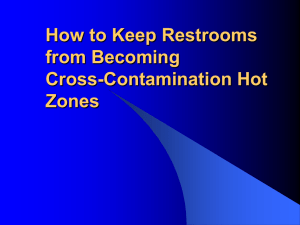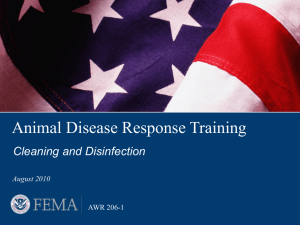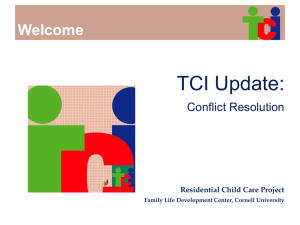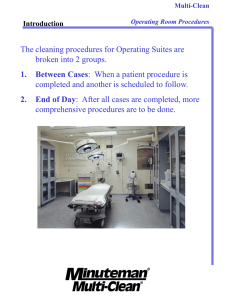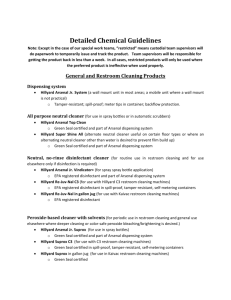Cleaning Restrooms and Shower Rooms
advertisement
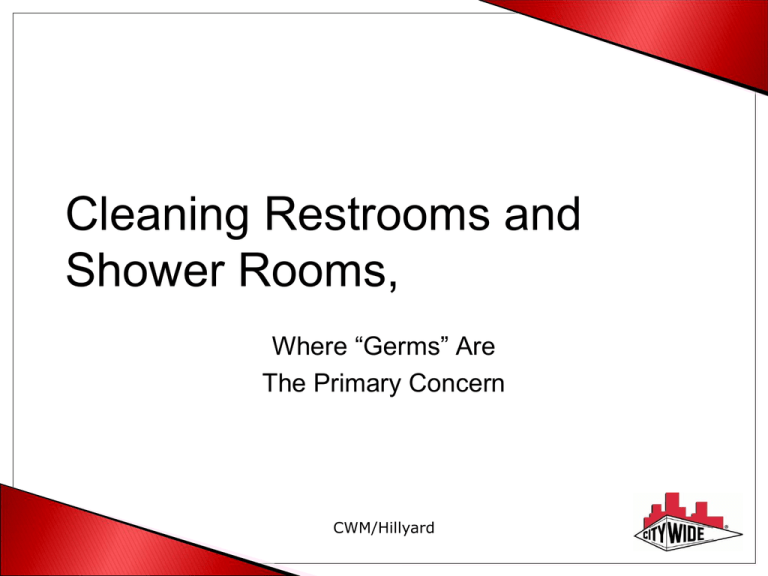
Cleaning Restrooms and Shower Rooms, Where “Germs” Are The Primary Concern CWM/Hillyard The Importance Of Clean Restrooms • Public perception – • Public health inspectors may close facility – – – – – • Caulking - cracked or missing Floors - corners, drains, under & around fixtures Fixtures - hard water crust - not working No soap / paper Walls - under & around fixtures Breeding ground – • Barometer of overall building cleanliness. Bacteria, viruses, fungi & odors To protect the health of occupants Sources of Building Complaints Trash Removal, 5% Other, 4% Trash Removal Entrances/Lobbies Carpets, 6% Carpets Dusting Floors Restrooms Entrances/ Lobbies, 5% Restrooms, 49% Dusting, 20% Other Floors, 11% A Clean Restroom Will Have No Odors • Clean Restrooms have a Neutral Odor – Not fragrances covering malodors – zero / neutral RESTROOM RENOVATION “Start Clean To Stay Clean” T.A.C.T. Principle • For products to work effectively, they need: – Time • Time to penetrate and loosen soils – Agitation • Soils won’t disappear without assistance – Concentration • Correct dilution – Temperature • Most products formulated for cold water only How Disinfectants Work • Disinfection occurs only if the solution is at the correct dilution. • Disinfectants lose effectiveness in relation to the amount of foreign matter suspended in the solution. “… In the presence of 5% serum…” • Take time to work – 100% kill = 10 min. How Do Disinfectants Work? • Sanitizers – Reduces the Number of Bacterial Contaminates to Safe Levels – Clean water and a clean cloth will sanitize a surface • Disinfectants – Agents that eliminate (kill) microorganisms How Disinfectants Work • Phenolics: Work by disrupting cell membranes and denaturing proteins – Disadvantages: irritating to skin; can cause skin depigmentation, irritating to nose and throat, toxic, dangerous to infants, poor water solubility, may discolor or otherwise damage surfaces with which they come in contact. – Some states consider discarded phenolic compounds to be hazardous waste How Disinfectants Work • Quat-based disinfectants carry a positive charge. Bacteria, viruses and fungi carry a negative charge. When a bacteria-laden surface is sprayed or mopped with a disinfectant, the charge distribution of the bacteria cell changes from negative to positive. This results in the disruption of the bacteria cell wall and eventual death to the microbe. How Disinfectants Work • Hypochlorites (Bleach) do not work well in the presence of soils, so surfaces must be pre-cleaned. – Highly caustic to skin and surfaces. – Highly reactive with other chemicals that easily release toxic gasses. – The odor is so strong when diluted correctly, that most people tend to use less than necessary for complete disinfection – Degrades quickly when diluted, exposed to air, or light. Germ Growth and Reproduction From One to 64 Billion in Just 12 Hours And so on … Are Restrooms Cleaned Every 12 Hours? Disinfecting... • For small restrooms or restrooms without a floor drain... – Use a 32 oz. Trigger sprayer, or… – Use a 2 qt. Pump-up sprayer, or… – Use a 2, or 3 gal. Pump-up shoulder sprayer. Disinfecting... • For restrooms with a floor drain… – Use Hillyard’s C-2 or C-3 “Touch Free Restroom Cleaning Machine” or a Foam Gun with appropriate metering tip. – Fill with properly diluted solution of disinfectant cleaner Disinfecting... • Spray all surfaces – All objects have 6 sides outside (if hollow also have 6 sides inside) spray as many as can be reached • • • • • Spray walls – top to bottom Partitions Under fixtures Inside & outside sanitary cans Allow dwell time… Disinfecting... • Agitate – – – – – – – – Use Appropriate Tools For The Surface... Cleaning Cloths Sponges Hand Pads Swivel Pad Holders Swivel Scrubbers Microfiber flat mop Scrapers Disinfecting... • Remember: – Disinfection occurs only if the solution is at the correct dilution • Disinfectants take time to work - ten minutes of dwell time for full kill Disinfecting... • Begin soft • Increase aggressiveness as necessary – Finest-first rule – Do no harm Disinfecting... • Wipe dry – Use a squeegee on large smooth surfaces • Walls, partitions, etc. • Polish chrome, porcelain – All surfaces with a shine (bright-work), should shine - no water spots or streaks • Apply any treatments • Refill dispensers Caution! • • • • • • Do not spray electrical outlets Do not spray into hand dryers Do not spray unsealed lights Do not soak drywall Do not soak millwork Do not spray fire sensors Floors… • Mop with Pulse micro-fiber Mopping System changing pads when soiled or every other restroom • Refinish if necessary After You’ve Finished... • • • • • • • Rinse pail and bowl mop - shake out excess water Spray with disinfectant and hang brush to air dry Clean and disinfect gloves Clean buffer & wet-vac – use disinfectant to prevent odors developing Clean micro-fiber pads, hang to dry Clean all tools used Don’t’ let your tools become a source of cross-contamination Daily Restroom Maintenance Keep Them Clean Restroom Maintenance • Wear appropriate personal protective equipment – • • • • • • OSHA – “…whenever there is a reasonable anticipation of contact with blood or other body fluids”. Spray all fixtures with Hillyard Non-Acid Restroom cleaner- doing this as the first step allows dwell time for the chemicals Vacuum the floor with a back vacuum or use a micro fiber dust mop to clean the floor Empty wastebaskets Stock all dispensers toilet paper, towels, soap etc. Use toilet brush to scrub inside of toilets/urinals getting all nooks and corners Wipe dry after cleaning all restroom surfaces Daily Cleaning • Sweep the floor • Empty wastebaskets - check soap dispensers & paper goods • Leave empties open • Use spray bottle of Hillyard Non-acid Restroom Cleaner to disinfectant all surfaces of toilets & urinals Disinfecting... • Using a trigger sprayer, or pump-up sprayer: – Apply disinfectant to sinks, mirrors and surrounding wall areas – Soap and paper towel dispensers or hand dryers and surrounding wall areas – Partition door handles, T.P. Dispensers and hand railings – Light switches (use caution!) – Entry door knobs or push panels – Toilet and urinal flush valves – Wall spots • Everywhere dirty hands touch Toilets and Urinals... • Scrub to clean • Flush several times to rinse – Rinse outsides with clean bowl water • It’s clean water – If the restroom is to be opened immediately, dry sinks, toilet seats – Use a clean dry micro fiber cloth to dry chrome surfaces – remove any spots or streaks and leave shiny surfaces shining Disinfecting.... • Wipe to clean - all sprayed areas - use cleaning cloths or paper towels – Re-spray as necessary to have enough liquid to clean (surfaces are already disinfected). • If the restroom is to be opened immediately, dry sinks, toilet seats • Use a clean dry cloth to dry chrome surfaces to remove any spots or streaks and leave bright work shining • Apply any surface treatments Floors... • Mop the floor with disinfectant/cleaner – Use micro-fiber Pulse Mopping System with Hillyard’s Suprox Weekly… • Use Hillyard’s CSP to prevent hard water build-up – Sinks – Toilets – Urinals • Be careful, don’t accidentally mix acid cleaners and disinfectants – in the fixtures or in your tools After You’ve Finished... • • • • • • Rinse pail and bowl mop - shake out excess water Spray with disinfectant and hang swab to air dry Clean and disinfect gloves Clean micro-fiber pads, hang to dry Clean all tools used Don’t’ let your tools become a source of cross-contamination Shower Rooms Renovation Shower Room Walls • Pour Hillyard’s CSP into a bucket • Spread with a doodle-bug with a black, brown or green hand pad, or a swivel scrub brush, or a Microfiber Flat Mop • Work bottom up to avoid streaking • Give it time to work – 10 to 15 minutes Shower Room Walls • Use a white hand pad, Microfiber cleaning cloth, or sponge – – – – For soap trays Shower heads Handles Grab rails Shower Room Walls • Scrub walls with doodle-bug, swivel scrub brush, or Microfiber Flat Mop • Rinse with water Shower Room Floors • Spread Hillyard’s CSP • Use scrub-grit brush or a black pad on a single disk floor machine • Scrub and rinse Shower Rooms Weekly Maintenance Shower Room Walls • Use Shower Foam with a Foam Gun • Or Hillyard’s C-3 or C - 2 “Touch Free Restroom Cleaning Machine” with Hillyard’s Mariner • Give the product its required dwell time to work Shower Room Walls • Agitate tough spots – With appropriate pad or brush • Rinse with clear water Shower Room Walls • • • • • Use disinfectant in foam gun with correct metering tip, or… Use in a pump-up sprayer Spray walls, fixtures etc. Do not rinse - allow to air dry Make sure acid cleaners are completely rinsed and flushed down the floor drains • Never mix acid cleaners with quat disinfectants Shower Rooms Daily Care As Easy As One; Two; Three... • 1. Sweep up debris (lobby broom and dustpan) • 2. Spray and wipe shower controls, heads, and soap dishes/dispensers with disinfectant - Hillyard’s Non Acid Restroom Cleaner and Disinfectant (allow dwell time) • 3. Mop the floor with disinfectant – Hillyard’s Non Acid Restroom Cleaner and Disinfectant Cleaning Restrooms and Shower Rooms Are there any Questions? Quiz 1. 2. 3. 4. 5. (T/F) Disinfectants achieve 100% germ-kill after 5 minutes dwell time. (T/F) There are three basic steps to cleaning the areas discussed: disinfecting surfaces to kill germs; acid cleaning fixtures to remove mineral deposits; and dusting. (T/F) shower rooms should be disinfected weekly. (T/F) The more thoroughly an area is cleaned daily, the less often the interim and renovative tasks will need to be done. Acid cleaners require dwell time. Quiz 6. (T/F) Restrooms and shower rooms, are cleaned with disinfectant/cleaner to prevent the spread of disease. 7. (T/F) Acid cleaners and disinfectant/cleaners can be mixed to speed the cleaning process. 8. (T/F) Gloves are only necessary when cleaning toilets & urinals. 9. OSHA requires you to after removing your gloves. 10. The three steps to daily shower room cleaning are: ; ; and . Answers 1. 2. 3. 4. 5. (F) Disinfectants achieve 100% germ-kill after 5 minutes dwell time. (T) There are three basic steps to cleaning the areas discussed: disinfecting surfaces to kill germs; acid cleaning fixtures to remove mineral deposits; and dusting. (F) shower rooms should be disinfected weekly. (T) The more thoroughly an area is cleaned daily, the less often the interim and renovative tasks will need to be done. Acid cleaners require 10-15 minutes dwell time. Answers 6. 7. 8. 9. 10. (T) Restrooms and shower rooms, are cleaned with disinfectant/cleaner to prevent the spread of disease. (F) Acid cleaners and disinfectant/cleaners can be mixed to speed the cleaning process. (F) Gloves are only necessary when cleaning toilets & urinals. OSHA requires you to wash your hands after removing your gloves. The three steps to daily shower room cleaning are: sweep up debris; disinfect shower fixtures; and damp mop floor with disinfectant. Cleaning Restrooms and Shower Rooms Thank you for your participation. CWM/Hillyard
